Potrebujeme váš súhlas na využitie jednotlivých dát, aby sa vám okrem iného mohli ukazovať informácie týkajúce sa vašich záujmov. Súhlas udelíte kliknutím na tlačidlo „OK“.
ASTM D4300-01(2013)
Standard Test Methods for Ability of Adhesive Films to Support or Resist the Growth of Fungi
Automaticky preložený názov:
Štandardné skúšobné metódy pre Schopnosť Samolepiace fólie na podporu alebo odolať rastu húb
NORMA vydaná dňa 1.10.2013
Informácie o norme:
Označenie normy: ASTM D4300-01(2013)
Poznámka: NEPLATNÁ
Dátum vydania normy: 1.10.2013
Kód tovaru: NS-26746
Počet strán: 8
Približná hmotnosť: 24 g (0.05 libier)
Krajina: Americká technická norma
Kategória: Technické normy ASTM
Kategórie - podobné normy:
Anotácia textu normy ASTM D4300-01(2013) :
Keywords:
adhesive film, biodegradation, biological testing, fungi, ICS Number Code 83.180 (Adhesives)
Doplňujúce informácie
| Significance and Use | ||||||||
|
4.1 These test methods are designed to be used to determine the susceptibility of the adhesive film to biodegradation and whether the adhesive will carry into the bond line sufficient anti-fungal properties to prevent growth of fungi frequently present on the gluing equipment, on adherends, or in the adhesive as applied. 4.2 Potato dextrose agar (PDA) provides a complete medium for the growth of fungi, while mineral salts agar (MSA) lacks a carbohydrate source and provides a less favorable medium. Use of PDA tests the adhesive film for its ability to resist the growth of fungi on its surface as well as its ability to repel a copious growth of fungi on the adjacent agar surface. Use of MSA tests the adhesive film primarily for its ability to resist the growth of fungi on its surface. When it is used, there is a reduced possibility that the growth from the agar will be mis-read as coming from the adhesive film, since fungal growth on the adjacent agar will be scant. 4.3 The results obtained when using
the procedures given in this method apply only to the species used
for the testing. The test species listed in Section 8 are frequently used by laboratories
to test for antifungal properties, but they are not the only ones
which could be used. Selection of the fungal species to test
against requires informed judgment by the testing laboratory or by
the party requesting the tests. These methods are especially useful
when species that have been isolated from contaminated adhesives
are used as the test species (see Section 8) to aid in the selection of more
effective fungicides.
4.4 The efficacy of some biocides may change in storage due to the chemical and thermal environment to which they are subjected as components of certain adhesives. These test methods are not appropriate for determining the effect of fungal contamination on adhesives under water-soaking conditions, because they are not designed to cover the possibility of water-soluble biocides leaching out of the bond line. 4.5 These test methods are dependent upon the physiological action of living microorganisms under a reported set of conditions. Conclusions about the resistance of the test adhesive to fungal attack can be drawn by comparing the results to simultaneously run controls of known resistance. See 1.1 These test methods test the ability of adhesive films to inhibit or support the growth of selected fungal species growing on agar plates by providing means of testing the films on two agar substrates, one which promotes microbial growth, and one which does not. 1.2 These test methods are not appropriate for all adhesives. The activity of certain biocides may not be demonstrated by these test methods as a result of irreversible reaction with some of the medium constituents. 1.3 A test method is included for
use with low-viscosity adhesives along with an alternative method
for use with mastic-type adhesives. Also, a method approved by the
government is given.
1.4 The values stated in SI units are to be regarded as the standard. The values given in parentheses are for information only. 1.5 This standard does not
purport to address all of the safety concerns, if any, associated
with its use. It is the responsibility of the user of this standard
to establish appropriate safety and health practices and determine
the applicability of regulatory limitations prior to use.
T487 Fungus Resistance for Paper and
Paperboard Available from Technical Association of the Pulp and
Paper Industry (TAPPI), 15 Technology Parkway South, Norcross, GA
30092, http://www.tappi.org. Method of Test for Effect of Mold
Contamination on Permanence of Adhesives Preparations and Adhesives
Bonds (Withdrawn 1982) Standard Practice for Determining
Resistance of Synthetic Polymeric Materials to Fungi (Includes all
amendments and changes 6/22/2021). Standard Terminology of Adhesives |
Podobné normy:
Historická
1.10.2010
Historická
1.10.2008
Historická
1.2.2008
Historická
1.5.2013
Historická
1.4.2011
Historická
1.10.2013


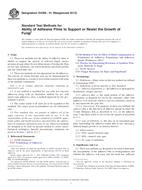
 ASTM D1002-10
ASTM D1002-10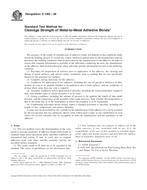 ASTM D1062-08
ASTM D1062-08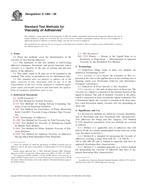 ASTM D1084-08
ASTM D1084-08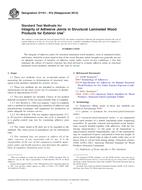 ASTM D1101-97a(2013)..
ASTM D1101-97a(2013)..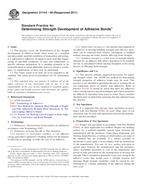 ASTM D1144-99(2011)..
ASTM D1144-99(2011)..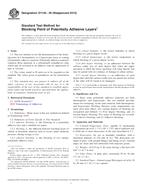 ASTM D1146-00(2013)..
ASTM D1146-00(2013)..
 Cookies
Cookies
